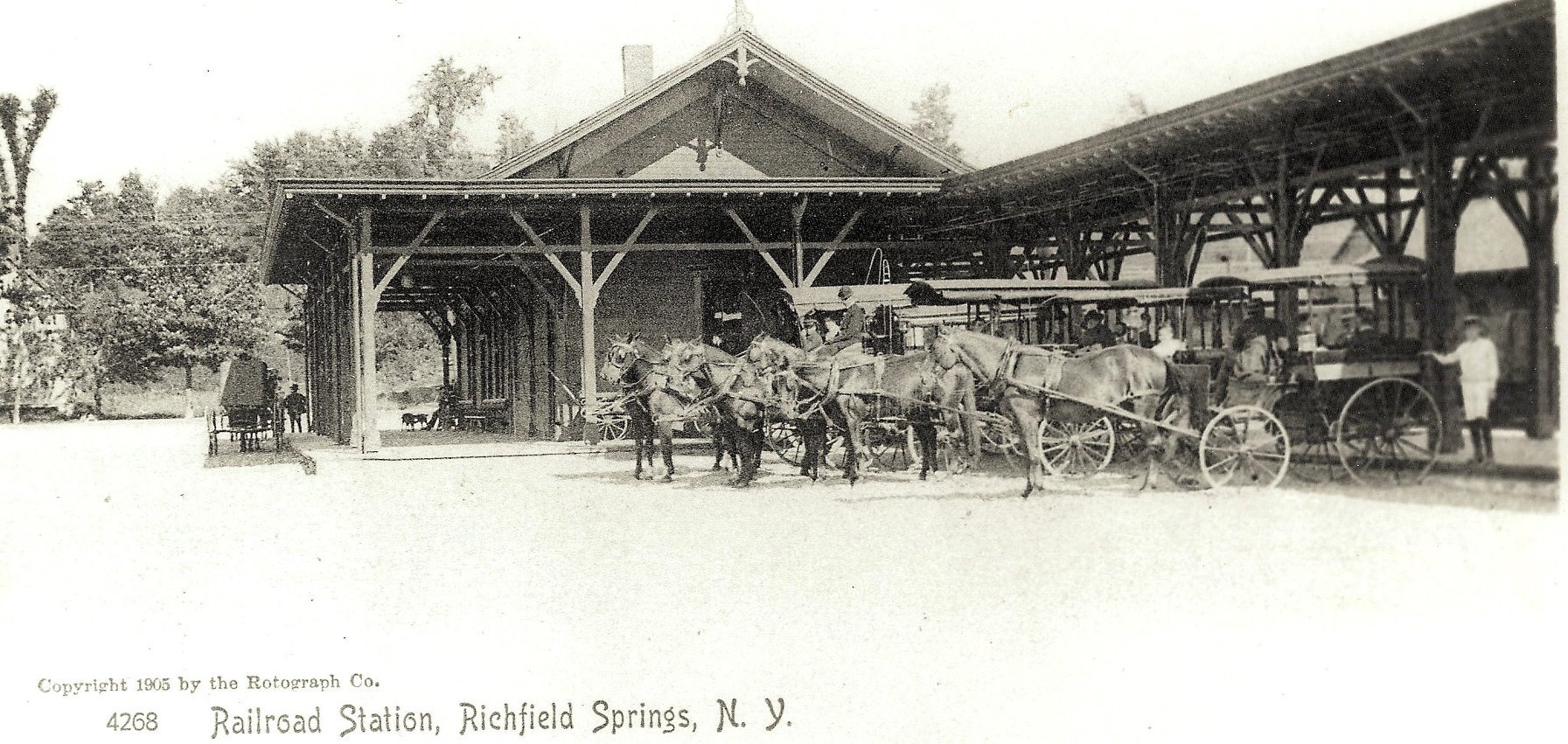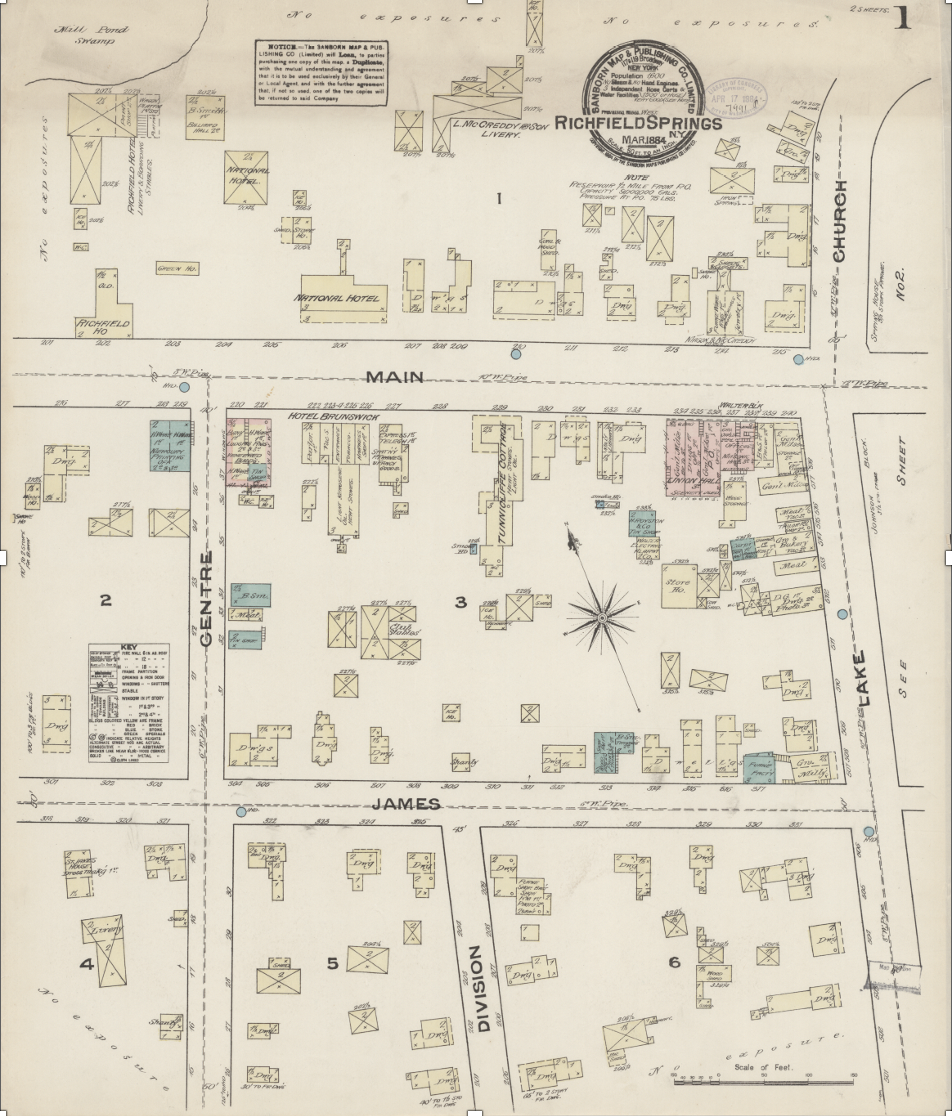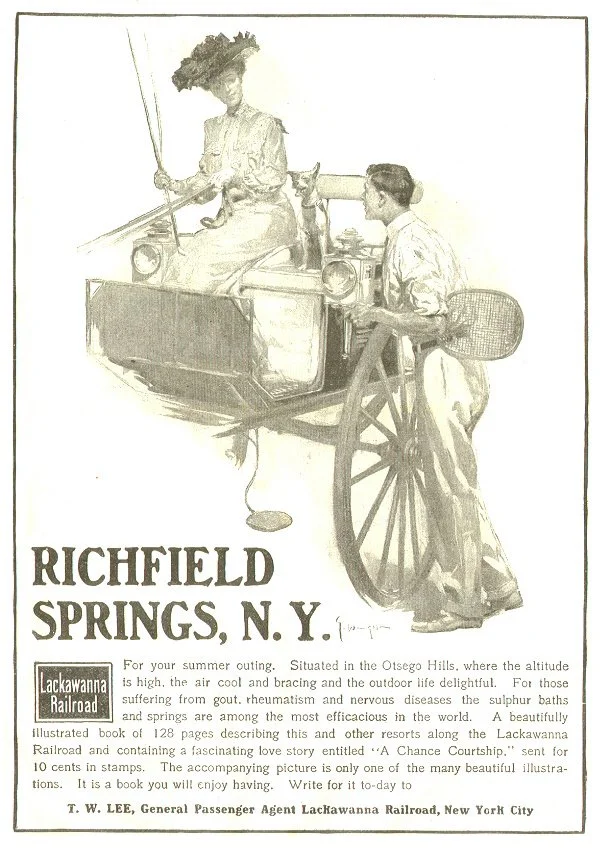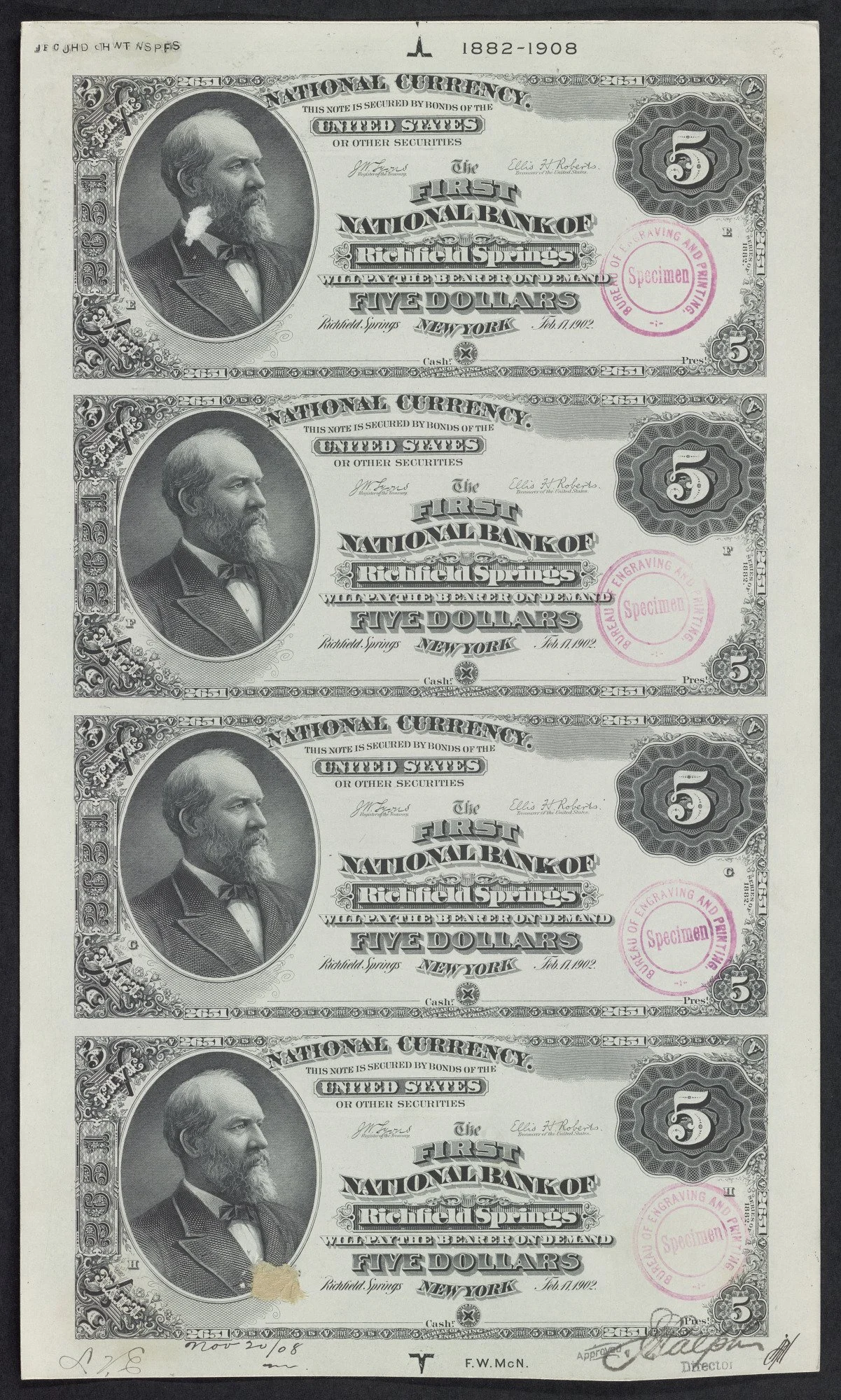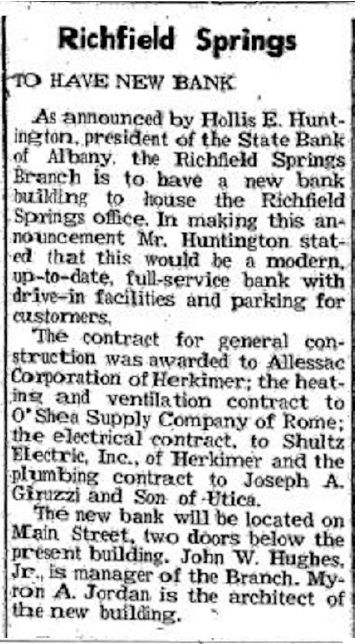
A thumbnail HISTORY of the former First National Bank of Richfield Springs and the Upstate New York community it served for generations
-

Community heritage
-

Outdoor recreation
-

Natural beauty
-

Downtown energy
-

Small business development
-

Community spirit
-

A healthy way of life
-
![https://www.albanyinstitute.org/collection/details/richfield-springs-taken-from-north-hill-otsego-county-ny]()
Early-1800s
By the early 1800s, the permanent settlements that will soon become known as “Richfield Springs” have taken root in the hills overlooking Lake Canadarago. These are the ancestral lands of the peoples then known to English-speaking settlers as the Five Nations and to the French as the Iroquois.
Native Americans valued the area for its hunting, fishing, and ‘medicine waters.’ The Oneida called the area Ga-no-wan-ges—‘stinking waters’—a reference to the pungent sulphur springs from which Richfield Springs would take its name and earn its early prosperity.
-
![Water-Cure for Ladies, page 120, by Marie Louise Shew]()
1820s and '30s |
As historian Anna Haddad reports in her blog for New York City’s Merchant House Museum, Richfield Springs became known as a spa resort in the 1830s, “after Dr. Horace Manley purchased the site of the Great White Sulphur Springs, built a bath house, and brought 25 patients to take ‘the water-cure’.”
Image: Water-Cure for Ladies, © 1844, by Mrs. M. L. Shew, revised by Joel Shew, M.D. (page 120)
-
![Postcard of Lake Canadarago, Richfield Springs, New York, circa 1900. Collection New York Public Library]()
1832 |
In 1832, a cholera outbreak in New York encourages those who can afford to flee the city’s heat and congestion for the whole summer to do so. NYC’s devastating loss will prove to be Central New York’s gain, as seasonal residents and summer travelers begin to discover the charms of “spa towns” like Richfield Springs.
The hydrotherapy craze for drinking and bathing in mineral waters fuels a wave of “health tourism.” Well-to-do city residents— suffering from maladies ranging from rheumatism to melancholia to boredom—pack up their summer finery and escape to the open spaces of Otsego County’s resort towns, where visitors are promised a well-balanced mix of “medicine” and amusement.
-
![RIchfield Springs, New York, Business Directory, Map, Published 1868, Collection of the New Yorl Public Library]()
1861
In 1861, the Village of Richfield Springs is incorporated on the northern edge of Lake Canadarago. Permanent population: 400.
The village is already a popular summer resort, with new businesses—catering to the needs of residents and tourists, alike—thriving all the way up and down Main Street.
Image: "Richfield Springs Business Directory; Richfield Springs [Village]," 1868. The New York Public Library Digital Collections, Lionel Pincus and Princess Firyal Map Division.
-
![]()
1870 |
The area’s reputation as a place “to see and be seen” grows among members of New York City’s fashionable elite.
A branch of the Delaware, Lackawanna, and Western Railroad extends to the southern edge of Richfield Springs in 1870—increasing direct access for day-trippers and well-to-do seasonal residents alike, bolstering the village’s booming post-Civil War economy.
The main hotels have dedicated stables, prepared to transport arriving guests (and their copious baggage) to their summer hideaways.
-
![A Gilded Age summer home built by industrialist Cyrus McCormick. Designed by architects McKim Mead and White. Grounds by Frederick Law Olmsted]()
1882 |
Gilded Age socialites, industrialists, tycoons, and bon vivants add Richfield Springs to their summer itinerary. The sulphur springs continue to flow—as does the fine Champagne—on Main Street.
In 1882, Cyrus McCormick—of mechanical wheat harvester fame—builds his summer estate in the village of Richfield Springs. The Shingle Style house is designed by the architectural firm of McKim, Mead, and White. Frederick Law Olmsted—already famous, with partner Calvert Vaux, for his plan for New York’s Central Park—designs the property’s pastoral landscape.
-
![First National Bank of Richfield Springs Under Construction circa 1882 to 1884]()
c. 1882–1884 |
The First National Bank of Richfield Springs is granted its charter in 1882.
The bank's board of directors commissions a three-story, brick-clad, timber-frame building on the corner of Center and Main Streets (formerly the site of a saloon).
The monumental building is strategically positioned at the core of the village’s thriving commercial corridor, a short stroll from the village’s “Great White Sulphur Springs.”
Image: Courtesy of the Richfield Springs Historical Association & Museum.
-
![First National Bank of Richfield Springs historical photograph circa 1884]()
Circa 1884 |
The First National Bank of Richfield Springs opens its new offices to the public at 118 West Main Street.
Elsewhere along the prosperous village's tree-lined streets, homes and businesses—including hotels and boarding houses with enough rooms to accommodate 2,000–3,000 seasonal visitors—continue to spring up, supported by a tourist trade appreciative of Otsego County’s fresh air and small-town atmostphere.
Image: Courtesy of Richfield Springs Historical Association & Museum
-
![Sanborn Fire Insurance Map March 1884 showing the former bank building]()
March 1884 |
The Sanborn Fire Insurance Map from March 1884 shows the brick-clad building on the corner of Center and Main Streets: At this time, the first-floor commercial space is shared by the First National Bank offices (on the eastern corner) and I. D. Peckham Hardware & Plumbing, with lodging upstairs.
Image: Sanborn Fire Insurance Map from Richfield Springs, Otsego County, New York. Sanborn Map Company, Mar. 1884. Map. Collection Library of Congress.
-
![Detail of period panoramic perspective map, drawn and published by L. R. Burleigh in 1885. Map Collection Library of Congress]()
By 1890 |
By the time of the 1890 census, the full-time population of Richfield Springs has swollen to 1,600 permanent residents—four times the number counted when the village was incorporated just 29 years earlier.
The three-and-a- half-story First National Bank building (captured here in an 1885 panoramic map) proudly stands in the heart of downtown Richfield Springs, 118 West Main Street.
Image: Detail from panoramic perspective map of Richfield Springs published by L.R. Burleigh and C.H. Vogt & Son, Troy, N.Y, 1885. Collection Library of Congress, Geography and Map Division.
-
![Turn of the 20th-century travel advertisement for Lackawanna Railroad with illustration of man in tennis attire, woman driving a buggy, and a fox terrier. entitled "A Chance Courtship" Pun probably intended]()
1902 |
Travelers continue to romance the rails into the early 20th century, when an electric railway connects Richfield Springs to the neighboring communities of Cooperstown, Mohawk, and Oneida.
Image: Advertisement published by the Lackawanna Railroad, c. 1902, promoting the unexpected benefits of a summer journey to the country—in this case a “courtship” (pun, no doubt, intended.)
-
![1914 advertisement announcing The New Vaults of the First National Bank of Richfield Springs, Composed of 12 Tons of Stone, Cement, Concrete, Railroad Rails. Burglar Proof Five-Ply Chrome Steel and Open Hearth Steel Guaranteeing ABSOLUTE SECURITY]()
1914 |
The First National Bank completes a major renovation of its building at 118 West Main Street.
The highlight: a 12-ton “burglar proof” steel vault designed to “Guarantee Absolute Security.”
Image: Advertisement of the First National Bank of Richfield Springs, Richfield Springs Mercury archives.
-
![Image of bank notes printed at the First National Bank of Richfield Springs. from the Collection of the Smithsonian National Museum of American History]()
Through 1935 |
According to the scholars of notaphily at antiquemoney.com, the First National Bank of Richfield Springs printed $1,382,620 in national currency between the receipt of its charter in 1882 through 1935—when the Federal Reserve took over the task from local banks throughout the country.
-
![Newspaper advertisement. Staff of State Bank of Albany, Richfield Springs Branch, September 1956]()
September 24, 1956 |
The Great Depression took its economic toll on the Village of Richfield Springs. Tourism tanked, hotels closed. Aided by the new ease of auto and air travel, tourists found new places to vacation. But faith in the conservatively managed local bank remained solid.
In 1956, the venerable First National Bank of Richfield Springs announces its merger with the State Bank of Albany.
The building at 118 West Main Street will continue to serve the public as the State Bank of Albany, Richfield Springs Branch.
-
![Newspaper clipping announces the State Bank of Albany to build a new bank in Richfield Springs with Drive Up window and off-street parking]()
September 1965 |
The State Bank of Albany’s Richfield Springs Branch, located at 118 West Main Street, announces its intention to build a modern new bank building “with drive-in facilities and parking for customers,” just a few doors away on Main Street.
Image: Richfield Springs Mercury archives.
-
![]()
20th-century challenges |
By the middle of the 20th century, Richfield Springs’ resort era had come to an end.
Its Main Street commercial corridor took a hard hit. Many small businesses closed.
But the village’s small town spirit remained strong. Concerts continued in the park. Folks came out for parades. Kids gathered at the lake, Spring Park, and the local pizza place—housed for a while on the first floor of the former First National Bank of Richfield Springs.
-
![]()
2023 |
Richfield Springs–based Dooalot, LLC develops a plan to revitalize the long vacant First National Bank building at 118 West Main Street. The building will undergo an extensive carbon-neutral retrofit designed to transform it into a mixed-use multifamily that once again serves the Richfield Springs community.
Dooalot, LLC, assembles a team of community-minded building professionals to bring their vision to life.
A once-in-a-century effort to restore and repurpose the beloved building has begun.




